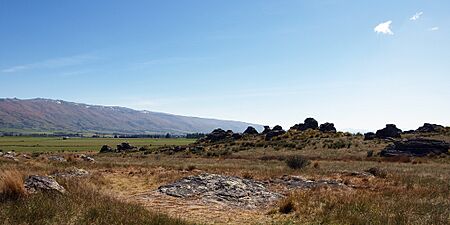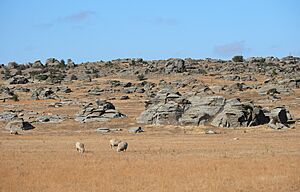Strath Taieri facts for kids
The Strath Taieri is a large valley in New Zealand's South Island. It's like a wide, flat area with a river running through it, surrounded by hills. Since 1989, it has been part of the city of Dunedin. The small town of Middlemarch is at its southern end.
The name "Strath Taieri" is a mix of two languages. Strath comes from old Irish and Scottish Gaelic, meaning a wide river valley. Taieri is the Māori name for the river that flows through the valley.
History of Strath Taieri
Early Times
Long ago, between 1300 and 1500, people who hunted the giant Moa birds lived and hunted in the Strath Taieri area. Māori people also used the valley as a path from the coast to the inland areas.
Later, around 1500 to 1642, a cave was found with the bodies of a Māori woman and child inside. It's not clear if they were trapped on purpose or by accident. Other sites in the area show that Māori used rock shelters for everyday life, keeping things like wooden bowls and tools for hunting birds or fishing.
In 1847, a European explorer named Charles Kettle saw the valley from a mountain and thought it would be great for farming animals. He was one of the first Europeans to visit Strath Taieri in 1851.
From 1857 to 1859, many farmers started renting land from the government in and around Strath Taieri. Some early European settlers came from Tasmania, Australia. One large farm, Cottesbrook, became a center for several sheep stations. Its buildings, made from local stone, are still there today.
Gold Rush and Railway
In 1861, the Otago gold rush began. This led to a stagecoach route, the Dunstan Trail, which passed near Strath Taieri. In 1864, gold was found at Hyde, at the northern end of the valley. For a short time, about two thousand people lived there hoping to find gold.
Edward Wingfield Humphreys is thought to have named the valley 'Strath Taieri'. His wife, Alice Humphreys, is believed to have named their private town 'Middlemarch' after a famous novel. This town was planned next to where the railway was going to be built. By 1891, Middlemarch had a hotel, houses, shops, a school, and tents for railway workers.
After 1876, the Taieri County was formed, which included Strath Taieri. This local government improved roads and built bridges, like the suspension bridge over the Taieri River at Sutton in 1885.
The Otago Central Railway started being built in 1879. It was planned to go through the difficult Taieri Gorge and then across Strath Taieri to Central Otago. The railway reached Middlemarch in April 1891, helping the town grow. It continued to Hyde in 1894 and eventually reached Cromwell in 1921.
To help Middlemarch, a local stream was moved, but the town still flooded often until the stream was properly managed. Churches were built in the early 1900s, including a beautiful Presbyterian church made from local stone.
Modern Times
Gold mining in nearby areas helped Strath Taieri grow, but this slowed down in the 1900s. In the 1880s, rabbits became a big problem for farmers, but they were finally controlled by the 1940s. The large farms were later divided into smaller ones, but the valley remained sparsely populated.
In 1939, Middlemarch got electricity. A sad event happened on June 4, 1943, when a train called the Dunedin Cromwell Express crashed near Hyde, and twenty-one people died.
After World War II, the area grew slowly. Farming increased, but the population didn't grow much and later even decreased. The landscape of Strath Taieri, with its unique rock formations, has inspired many artists and writers. For example, the famous New Zealand painter Colin McCahon was inspired by the landscape in 1936. The poet James K. Baxter also wrote about the area.
In the 1960s and 1970s, the natural grasslands were changed into European-style pastures for farming. In 1989, the local government changed, and Strath Taieri became part of the larger City of Dunedin.
In 1990, the Central Otago Railway closed. However, a special tourist train now runs from Dunedin to Strath Taieri through the Taieri Gorge. Since 1991, this train has been run by the Taieri Gorge Railway Limited. In 1993, the old railway track further inland was turned into the Otago Central Rail Trail, a popular path for walkers and cyclists. Both of these have been very successful in bringing visitors to the area.
Strath Taieri's growth has always depended on changes in farming and transport. Even though the railway closed for heavy goods, the main road (State Highway 87) was fully paved by 1996, making transport easier. With more tourism, including people driving, walking, and taking the train, the area has found new ways to connect with the rest of New Zealand.
The area's rural feel has even led to the unexpected success of "bachelor dances," which are events meant to help single men in the area find partners. These events have attracted visitors from all over the country and even overseas, making Strath Taieri known to many more people.
Education
As of 2021, there is one primary school in the Strath Taieri District, located in Middlemarch. In earlier times, there were several schools in the area.




